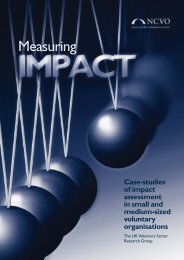A guide to third sector trading - WCVA
A guide to third sector trading - WCVA
A guide to third sector trading - WCVA
Create successful ePaper yourself
Turn your PDF publications into a flip-book with our unique Google optimized e-Paper software.
It’s an idea, but is it business? A <strong>guide</strong> <strong>to</strong> <strong>third</strong> sec<strong>to</strong>r <strong>trading</strong><br />
1: Getting<br />
started<br />
2: First steps 3: Business<br />
planning<br />
4: Legal and<br />
governance<br />
5: Funding<br />
and<br />
resourcing<br />
6: Financial<br />
controls<br />
7: Managing<br />
growth<br />
8: Management<br />
and<br />
governance<br />
9: Social<br />
enterprise<br />
10: Sources<br />
of support<br />
Charitable Incorporated Organisations (CIOs)<br />
A better option for charitable companies: The new CIO<br />
structure, which is due <strong>to</strong> come in<strong>to</strong> operation in 2011, combines<br />
the previous two tier process of registering a company limited<br />
by guarantee and then registering it as a charity. The following<br />
compelling list of advantages have been persuasively advanced<br />
by the UK government, and it is hard <strong>to</strong> see why new charitable<br />
companies in future would want <strong>to</strong> use the former approach. It<br />
remains <strong>to</strong> be seen whether it is worthwhile for existing charitable<br />
companies <strong>to</strong> convert <strong>to</strong> CIOs.<br />
• Single registration: A CIO will need <strong>to</strong> register with the Charity<br />
Commission alone, whereas a charity that is a company needs<br />
<strong>to</strong> register with the Charity Commission and the Registrar of<br />
Companies. A major problem up <strong>to</strong> now has been that there was<br />
often no assurance that the charitable objectives of the limited<br />
company would be acceptable <strong>to</strong> the Charity Commission.<br />
• A single annual return and simpler reporting: A CIO will be<br />
required <strong>to</strong> prepare only one annual report, under the Charities<br />
Act 1993. A CIO will make one annual return under charity law,<br />
whereas a charity that is a company must prepare an annual<br />
return under company law and, if it has an annual income of<br />
over £10,000, it must prepare a separate annual return under<br />
charity law.<br />
• Simpler filing requirements: A CIO will be required <strong>to</strong> send<br />
its accounts, reports and returns <strong>to</strong> the Charity Commission,<br />
whereas a charity that is a company also needs <strong>to</strong> send them <strong>to</strong><br />
the Registrar of Companies.<br />
• Simpler requirements on changing the constitution: A CIO<br />
does not need <strong>to</strong> report <strong>to</strong> the Registrar of Companies.<br />
• Lower costs: The Charity Commission does not make any<br />
charges for registration and filing of information.<br />
• Other benefits:<br />
− simpler constitutional forms, and, it is claimed, greater<br />
constitutional flexibility<br />
− easier charity mergers<br />
− an enforcement regime that does not penalise the CIO itself<br />
for misconduct by its direc<strong>to</strong>rs.<br />
• Conversion: It will be extremely simple <strong>to</strong> convert charitable<br />
companies and charitable industrial and provident societies<br />
<strong>to</strong> CIOs. Converting charitable trusts and unincorporated<br />
associations <strong>to</strong> CIOs should also be relatively straightforward.<br />
94












